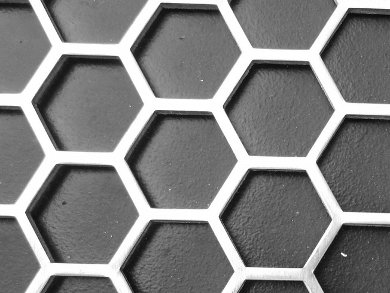Nanowires made from semiconducting organic compounds are promising components for optoelectronic devices. They combine good light sensitivity, efficient charge carrier transport, and high surface areas. However, photovoltaic devices based on organic nanowires can be difficult to make because it is hard to connect the nanowires to electrodes in a controlled manner.
Emanuele Orgiu, Paolo Samorì, University of Strasbourg and CNRS, Strasbourg, France, and colleagues have developed a strategy to simultaneously connect hundreds of supramolecular nanowires to nanoelectrodes. The team prepared a honeycomb-like scaffold containing millions of nanoelectrode “holes” using a stepwise approach. They combined nanosphere lithography, which uses a gold nanosphere monolayer as a template, with reactive ion etching to generate the scaffold’s structure.
The nanowires were formed by self-assembly of an n-type (electron-transporting) organic semiconductor, N,N′-dioctyl-3,4,9,10-perylenedicarboximide (PTCDI-C8). Then they were turned into uniform films floating at a water/air interface, transferred onto the nano-mesh scaffold, and thermally annealed under an inert atmosphere.
After the nanowires were connected to the nanoelectrodes, the researchers observed a photovoltaic effect, which they attribute to light absorption by the nanowires. The synthesis method allows the team to adjust the width and the thickness of the nanowires, as well as the size of the nanoelectrodes. The device’s properties could be further tuned by deposition of a thin layer of a hole-transporting semiconducting polymer on the electrode. The prepared photovoltaic device has an external quantum efficiency of over 55 %, a signal-to-noise ratio of 107, and a fast response time of 10 ns.
According to the researchers, this approach could be helpful for further studies of organic nanostructured optoelectronic and spintronic devices, such as light-emitting diodes (LEDs) or spin-valves.
- A nanomesh scaffold for supramolecular nanowire optoelectronic devices,
Lei Zhang, Xiaolan Zhong, Egon Pavlica, Songlin Li, Alexander Klekachev, Gvido Bratina, Thomas W. Ebbesen, Emanuele Orgiu, Paolo Samorì,
Nat. Nanotechnol. 2016.
DOI: 10.1038/nnano.2016.125




![Synthesis of [c2]Daisy Chains via Mechanochemistry](https://www.chemistryviews.org/wp-content/uploads/2025/04/202504_RotaxanesWithSolidStateMechanochemistry-125x94.png)